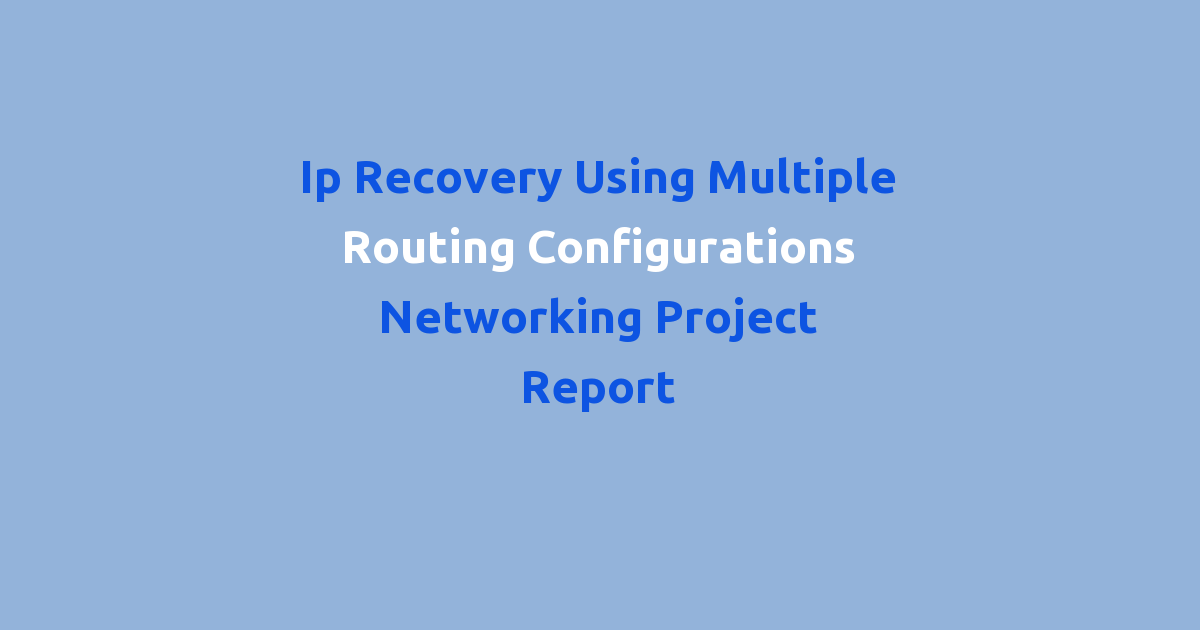In our networking project report, we implemented various routing configurations to enhance IP recovery.
IP Recovery using Multiple Routing Configurations Networking Project Report
Introduction
In today’s modern world of technology, networking plays a crucial role in connecting various devices and systems. With the increasing reliance on the internet for communication and data transfer, ensuring uninterrupted connectivity is of utmost importance. One of the key challenges faced in networking is IP recovery in case of network failure. In this project report, we will discuss the existing system for IP recovery using single routing configurations and propose a new system that utilizes multiple routing configurations for improved reliability and efficiency.
Problem Statement
The existing system for IP recovery relies on a single routing configuration, which poses a significant risk in case of network failure. If the primary route fails, the entire system is at risk of losing connectivity, leading to downtime and potential data loss. This single point of failure is a major concern for organizations that rely heavily on network connectivity for their operations.
Existing System
The existing system for IP recovery utilizes a single routing configuration, where all traffic is routed through a primary route. In case of network failure on the primary route, the system switches to a secondary route for recovery. However, this system has several disadvantages:
1. Single point of failure: The reliance on a single routing configuration makes the system vulnerable to network failures on the primary route.
2. Limited reliability: Switching to a secondary route may not always guarantee seamless recovery, leading to potential downtime.
3. Inefficient use of resources: The system may not make optimal use of available resources, leading to performance bottlenecks.
Disadvantages
The disadvantages of the existing system highlight the need for a more reliable and efficient solution for IP recovery. By relying on multiple routing configurations, we can address these drawbacks and ensure uninterrupted connectivity even in case of network failures.
Proposed System
The proposed system for IP recovery involves implementing multiple routing configurations to ensure redundancy and reliability. By distributing traffic across multiple routes, the system can continue to operate seamlessly even in the event of network failure. The key features of the proposed system include:
1. Route diversity: Utilizing multiple routing configurations ensures that traffic can be rerouted through alternate paths in case of failure on the primary route.
2. Load balancing: By distributing traffic across multiple routes, the system can optimize resource utilization and prevent performance bottlenecks.
3. Fault tolerance: The system is designed to withstand network failures and ensure uninterrupted connectivity for critical operations.
4. Fast recovery: In case of network failure, the system can quickly switch to an alternate route to minimize downtime and prevent data loss.
Advantages
The proposed system offers several advantages over the existing system for IP recovery, including:
1. Enhanced reliability: By utilizing multiple routing configurations, the system can ensure continuous connectivity even in case of network failures.
2. Improved performance: Load balancing across multiple routes optimizes resource utilization and reduces the risk of performance bottlenecks.
3. Greater flexibility: The system can adapt to changing network conditions and reroute traffic to ensure seamless operation.
4. Enhanced security: By diversifying routes, the system can mitigate the risk of cyber attacks and unauthorized access.
Features
The key features of the proposed system for IP recovery using multiple routing configurations include:
1. Dynamic routing: The system can dynamically adjust routing configurations based on network conditions and failures.
2. Redundant paths: Multiple paths are available for traffic rerouting to ensure continuity of operations.
3. Automated failover: In case of network failure, the system can automatically switch to an alternate route for recovery.
4. Monitoring and alerting: The system includes monitoring tools to track network performance and alert administrators in case of issues.
5. Scalability: The system is designed to scale with the growing needs of the network and accommodate additional routes as needed.
Conclusion
In conclusion, the proposed system for IP recovery using multiple routing configurations offers a more reliable and efficient solution for ensuring uninterrupted connectivity in case of network failures. By leveraging route diversity, load balancing, fault tolerance, and fast recovery, the system can address the limitations of the existing system and provide enhanced reliability, performance, flexibility, and security. This project report highlights the need for innovative solutions in networking to meet the demands of today’s interconnected world.

